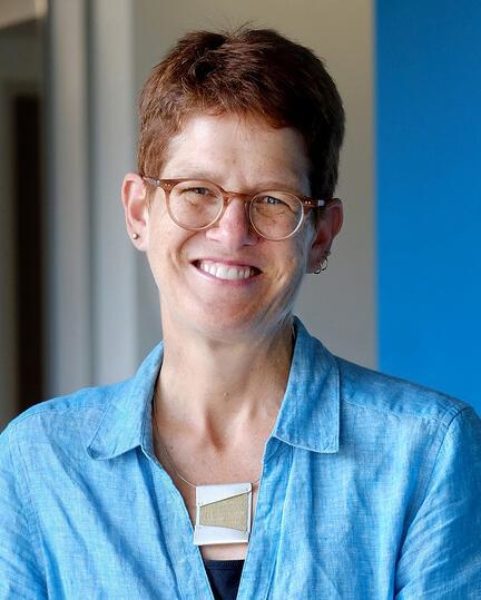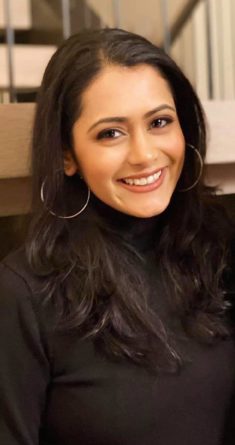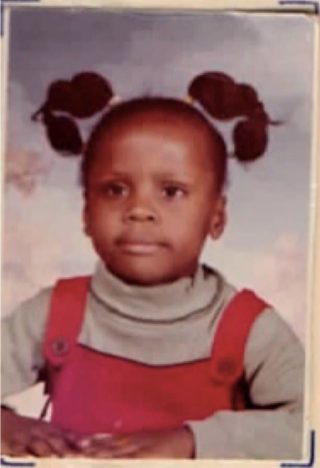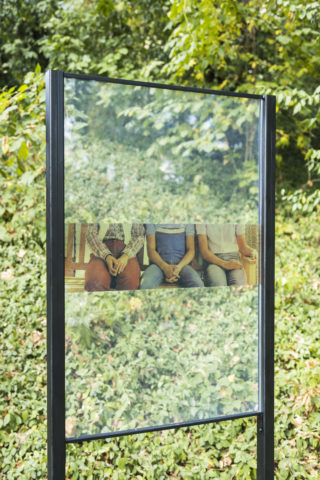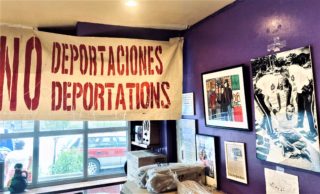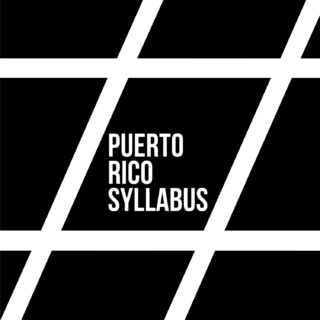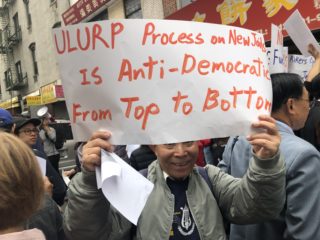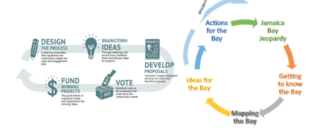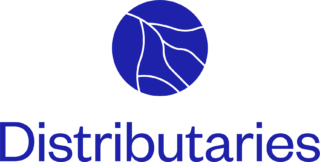
Via this series of interviews, Distributaries seeks to sketch out the contours of the public humanities ecosystem—the centers, institutes and initiatives undertaking the work of the public humanities—at the City University of New York. Apart from sharing the specific work these programs and centers do, we also wish to offer up their visions of the “public humanities” as a field, and the rich ways in which the ethos of this term is realized.
In this interview, conducted in November 2021, I spoke to Anne Valk, Executive Director of the American Social History Project (ASHP), a research center affiliated with the Graduate Center, CUNY. We chatted about ASHP’s mission and work, oral history as a public humanities methodology, how public humanities centers have navigated the climate of perpetual austerity by engaging in generative collaborations with each other, and more. Something that’s going to stick with me for a while is her parting advice to graduate students: Don’t give up the public engagement work you want to do because your mentors, or others in the academy, don’t support it; rather, find the people who can be your cheerleaders as you follow the path you feel most strongly called to—words to live by, truly.
–Queenie Sukhadia
Queenie Sukhadia (QS): Can you tell me a little bit about the ASHP?
Anne Valk (AV): One thing I would like to say at the outset is that I’m new to CUNY, to the Graduate Center, and to the ASHP. I started as Executive Director and a member of the faculty in history at the end of January 2020.
ASHP has a pretty long history. It’s been active since the early 1980s and has been connected to the Graduate Center since the mid-’90s. ASHP’s roots are in US social history and labor history. It was started with an emphasis on thinking about how the history of American workers, and the American working class in particular, could be and was relevant to people outside of academic settings. So, a lot of ASHP’s early work was with members of labor unions, for instance. It was deeply involved in worker education. Along the way, ASHP has also done a lot of work in terms of creating resources for people who want to teach and learn US social history in other kinds of contexts. Increasingly, there’s also been an emphasis on working with educational materials for K through 12 or particularly middle and high school teachers. When I got to ASHP in 2020, that was a lot of the work that was ongoing; it included everything from professional development seminars to workshops for teachers, and so on. We also have a history of doing summer institutes for higher-ed faculty as well as curriculum development for middle and high school faculty.
We’re also in the midst of a big grant-funded multi-year project to update Who Built America, which is a textbook that was initially published by ASHP back in the ’80s and has been through several editions since then. What we’re working on now is turning it into an open-access educational resource and expanding the content. Those are the kinds of things that ASHP has been doing most recently. Almost all of our work is grant funded. So, to some extent, our priorities and the kinds of projects that we work on are also driven by what we can get funded—by the whims and the agendas of the large granting agencies. For us, that’s mostly been the NEH—they’ve been one of our primary funders over the years.
QS: That’s a portfolio of diverse and really important, interesting work. The task of naming one’s audience has been on my mind a lot in relation to public humanities work. People often say their audience is everybody, but then that also ends up being nobody. So, if you had to specifically name ASHP’s audience—who ASHP serves—who would that be?
AV: That’s a really good question. And my guess is that if you talk to different people connected with ASHP, they might answer that question differently. But for me, I think ASHP’s audiences are currently mostly teachers, and that includes middle and high school teachers, community college teachers, higher-ed teachers.
As I hinted at earlier, I think that in ASHP’s history the audience has been broader than that, but currently that’s the main audience. I guess I would also include students—both the students of the teachers that I just mentioned, but also students at the Graduate Center. For instance, there’s a whole other arm of what ASHP does that I haven’t mentioned at all yet, which is that we run the New Media Lab, which is a resource for students at the Graduate Center who are interested in developing digital tools to enhance their research or to extend the audience for their research.
QS: Wow, that’s a broad swath of audiences cut across the US education system, really. So, based on all that we’ve talked about so far, would you say that you see ASHP’s work as falling within the umbrella of the public humanities?
AV: I don’t really think so, and this may just reflect my short tenure with ASHP, and how ASHP compares to other kinds of work that I’ve done at other institutions. I guess I’m thinking about the kind of work that ASHP does in relation to both audience and process. And so, in terms of audience, I think at this point we’re mostly reaching out to students and teachers. We’re very focused on thinking about the public accessibility of materials, yes, but I think we’re particularly interested in how these materials are going to be used within either a classroom setting or by people who are using them to benefit their academic work. And, so, while all the materials are online and they can be accessed by other publics, we don’t know how much they are being used by them.
The issue of process is something that I’ve also thought a lot about in terms of public humanities, and it partly reflects the kind of work that I’ve done before, working on projects that are intentionally organized to be very collaborative in their development—that really think about how to create research processes that are collaborative, either in terms of involving people from outside the academy to shape the research questions or involving them in actually collecting, reviewing and/or presenting the materials in various ways. Although ASHP has done that in the past with things like teaching workshops, where teachers were directly involved in helping to develop and then test the materials before ASHP makes them publicly accessible, right now we haven’t been doing that. It’s been much more one-sided—an outreach model almost—where the materials are developed, prepared, and presented by ASHP and then lots of different audiences use them.
So, overall, the reason I’m hesitating to see ASHP’s work as part of the “public humanities” is because what I see missing, for lots of reasons, is that more collaborative kind of approach.
QS: I’m also curious about this because you mentioned that a lot of what ASHP does is driven by the priorities of the grant-making organizations. Do you think this kind of collaborative work tends to be less or more funded?
AV: I do think that foundations such as Mellon have put a lot of emphasis on the kind of collaborative work that I just spoke about, particularly when it is initiated, led, and directed by non-academic institutions. So, I think some funders are really emphasizing that kind of work right now. The Whiting Foundation Public Engagement Program is another great example of a foundation that’s actively trying to support these kinds of collaborations between academics and non-academic communities.
But, in general, I think those kinds of collaborations are still underfunded. It feels like a moment of incredible uncertainty around where humanities funding is headed, really. Like: Are we going to come out of this moment—this pandemic—with the sense that, on a larger national scale, humanities funding is not what’s most important right now? That money needs to be more directed toward public health, for instance, or behind what they’re calling civics education? I really don’t know how humanities funding, and especially public humanities funding, is going to fit into what is going to be a vastly reconfigured landscape.
Are we going to come out of this moment—this pandemic—with the sense that, on a larger national scale, humanities funding is not what’s most important right now?
QS: That leads directly into my next question, which is about ASHP being situated at an institution like CUNY. And I mean that in two senses: one, the public dimension of CUNY and its mission to serve all the people of New York, but also in terms of the constant environment of austerity within which CUNY operates. So, what’s your take on ASHP’s affiliation with an institution like CUNY?
AV: In some ways, I suspect that this constant austerity encourages collaboration within programs and departments that might not otherwise exist. For instance, with ASHP—we just got a very small bit of money to be part of an LGBTQ+ consortium that’s being spearheaded by some people at LaGuardia Community College, and they have money from the New York City Council to try and seed LGBTQ+-focused activities at the different CUNY campuses. So ASHP, along with CLAGS, the Public Science Project, and some people from the library, created an internal consortium to do LGBTQ-related activities in spring 2022. I think I can say with confidence that that consortium wouldn’t have happened, or that ASHP wouldn’t have been looking to be part of that consortium, if it hadn’t been for the sense that—oh, here’s a good way for us to collaborate with people at the GC and there’s some financial reward to doing that!
I think CUNY is absolutely the right place for an organization like ASHP. There’s a real compatibility between the two—a sense of shared mission about the purpose of education, and the way in which history can be and should be part of that. ASHP’s mission, more generally, is about how we can create opportunities for people to learn about what historians call “history from the ground up.” How do we do history in a way that really reflects the lives of ordinary Americans, of people who are part of the working classes and people whose stories and lives have been marginalized in many ways? I think that’s who CUNY tries to serve, and that’s also whose stories ASHP most wants to tell. So, philosophically speaking, I think there’s a great fit between ASHP’s mission and CUNY’s mission.
QS: You also mentioned that you haven’t been at CUNY very long, but I’m still curious: What is the biggest challenge you have faced in your work with ASHP thus far?
AV: I think it’s just been trying to understand an institution and the institutional context, especially where there’s an incredibly complex bureaucracy—figuring out how to get stuff done. And I think that would have been a challenge even if we hadn’t been working from home for the last year and a half, but it’s been a particular challenge because of that as well. All the leadership changes at the GC have also coincided with that, and that’s made things particularly challenging.
The funding issues are both GC-specific and related to that larger funding problem nationally right now. We’re in a situation—and this is very related to funding—where we’re trying to figure out how we can continue our work, when almost all of our work is grant-funded but those grants never really cover the actual cost of the work we’re doing. We’re chasing all these grants to ensure that half of our staff can keep working. But, chasing all of these grants means that we’re having to take on more work than we can actually physically complete. So, we have to chase those grants, but chasing the grants itself takes a lot of time, and then once we get them, we’ve committed to doing more work than we can possibly do. But it does ensure that the staff can keep their jobs.
QS: That’s a lot of pressure. What always fascinates me, though, is that we’re operating in a constant environment of scarcity, but people have so much creativity, so much optimism, that even though we don’t have the funds, we’re going to do all of these things to keep afloat and forge on.
AV: I’m so glad you said that because it just made me think: I guess at the foundation of a lot of this work, especially work that’s trying to be public facing, there’s a lot of optimism—a belief that this work matters and that it can make a difference. And then maybe that outlook is also part of what allows us to have a sense that we’ll figure it out somehow.
QS: Absolutely. I was also looking at some of the work you do and was really fascinated by the fact that so much of it is centered around oral history, which is increasingly being used as a public humanities methodology, with podcasting, for example. So, I was wondering whether you see the method of oral history as particularly conducive to facilitating public collaboration and engagement?
AV: Yeah, it’s a really good question. I mean, for me, oral history was my route into public humanities and into really wanting to have a career that incorporated opportunities to do work with and for publics outside of the academy. So, I would say yes. Although I’m also aware that oral history doesn’t necessarily lead to that either—there are a lot of oral historians who use the method and see it as something that’s really part of a much more traditional form of academic scholarship.
I think oral historians also have been really important in thinking through a lot of the issues around how one can do publicly engaged work in a collaborative way. What are the methods? What are the ethical issues? What are the responsibilities of researchers toward the publics that they’re working with?
QS: I want to close out this interview by asking you if you have any advice for GC or CUNY students who want to study non-traditional research artifacts as part of their scholarly work or address their research to publics beyond the university?
AV: I guess I would say: find the people who can support you in doing that work, because there are many, many barriers to doing it still. These barriers include faculty who are going to say: that’s not important, or you shouldn’t do that. There’s still a tremendous amount of resistance. And so, it’s key to find people who are going to support you, who are going to be your cheerleaders, and from whom you can learn, who offer advice and support. In my own experience, a lot of that has come from people outside of my academic discipline. So, it may mean really thinking about who are the people, perhaps in other fields and other disciplines, from whom you can learn and whose work is really going to enrich your own understanding about how to do this work.
It’s key to find people who are going to support you, who are going to be your cheerleaders, and from whom you can learn, who offer advice and support.
When I first started doing a lot of this work, I was at an institution that was a member of Imagining America, which is a national network of artists and scholars who are involved in publicly engaged scholarship. That organization gave me a lot of support and connected me with many relevant networks; it has also been actively involved in thinking about graduate education. I think it’s a really good home for people who are interested in doing this kind of work. In my case, the Oral History Association has also been really important. I also learned a tremendous amount from people in environmental studies, which was not my area of work at all, but it is an area where there are a lot of academic-based researchers who are doing publicly engaged scholarship that’s deeply collaborative.
So, yes, I would really urge folks to go out there and find their people!

